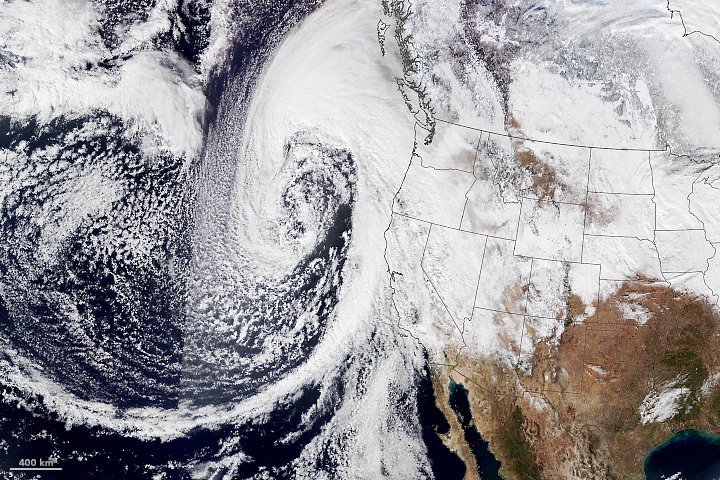California’s Record-Breaking Rainfall and What it Means for the Future
California and other states in the western United States have been battered recently by an onslaught of storms originating from the Pacific Ocean. These types of storm events, coined “atmospheric rivers” by meteorologists, are characterized by a rich plume of moisture originating from more tropical areas of the oceans [1].
Image captured from Visible Infrared Imaging Radiometer Suite (VIIRS) on the NOAA-20 satellite of an extratropical cyclone, with its associated plume of moisture, headed towards California on Wednesday, January 4, 2023. Image borrowed from https://earthobservatory.nasa.gov/images/150804/atmospheric-river-lashes-california.
California is no stranger to atmospheric rivers, particularly during the winter months, but this recent string of storms poses a significant risk to communities throughout the state. Although the state is suffering from a severe drought that has persisted for years, the recent heavy rains over such a short time have proven to be too much of a good thing. Continuous, heavy rain that falls in a short window of time often proves to be deadly in California, as the state’s topography can funnel large amounts of water into nearby communities, leading to intense flooding and mudslides [1]. These have the potential to severely affect the communities and structures most vulnerable to the impacts. California Governor Gavin Newsom declared a state of emergency on Wednesday ahead of the most recent storm’s arrival, all the while the city of San Fransisco ran out of sandbags for the second day in a row as residents scrambled to protect their homes from the likelihood of flooding [1].
In addition, drought conditions affect the ability of soil and root systems to absorb moisture [2]. Soil can hold only so much water at any given time. With saturated ground excess rainfall is likely to run off and exacerbate flooding instead of percolating into the soil. Runoff is also enhanced during drought conditions, which limit the ability of tree roots to quickly soak up water [2]. In addition, drought makes root systems weaker and, as a result, trees become more susceptible to falling during extreme flooding [1].
It’s important to discuss California’s recent storms in the broader context of rainfall-induced flooding. Climate change is increasing the moisture capacity of the atmosphere, which has been leading to more extreme flooding events and rainfall records globally [3]. In a state like California, which is increasingly susceptible to severe drought under climate change [4], one can conclude that these intense bouts of rain will continue to become more prevalent while the state reels from decade-long droughts. This ultimately means that communities and insurers should be more prepared than ever to deal with the aftermath of flooding rains, mudslides, downed trees, and damaged properties throughout the state.
Schematic displaying the effect of a 1-degree Fahrenheit increase in temperature on the available water vapor content in the atmosphere. The relationship between water vapor and temperature is an exponential one, meaning that continued Earth warming will further accelerate the atmosphere’s ability to hold moisture. Image created by Diana Chao.
Continued warming will increase the likelihood of extreme rainfall events, and this issue extends well outside of the state of California [3]. For example, in 2022, Hurricane Ian produced what was termed as “1,000-year flooding” in parts of Florida, causing the insurance industry throughout the state to go into shock [5]. Here at Kinetic Analysis Corporation, we provide our clients with global, high-quality, high-resolution data related to rainfall, waves, and storm surge from tropical cyclones. This data is available both in real-time as the events themselves are unfolding and for historical storms. As scientists, we understand the challenges that come with a warmer world and the need to adapt operations to build climate-resilient businesses and infrastructure. If you are interested in learning more about how to protect your assets in the face of climate change, please reach out to sales@kinanco.com.
References:
1. https://www.vox.com/science-and-health/2023/1/6/23542194/california-atmospheric-river-flood-drought
2. https://www.frontiersin.org/articles/10.3389/fpls.2015.00547/full
3. https://www.nature.com/articles/s41467-020-18876-w
4. https://www.pnas.org/doi/10.1073/pnas.1503667112
5. https://www.nesdis.noaa.gov/news/hurricane-ians-path-of-destruction
6. https://earthobservatory.nasa.gov/images/150804/atmospheric-river-lashes-california


